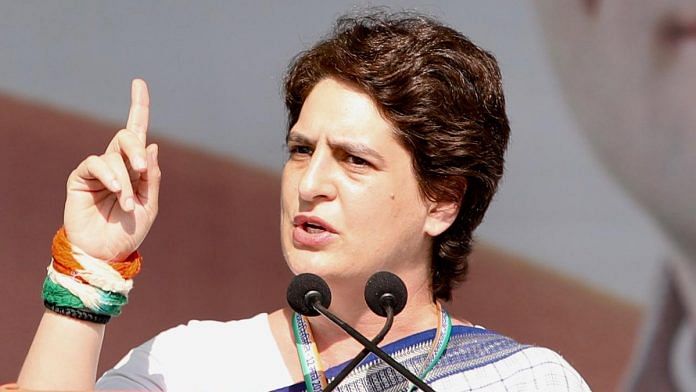New Delhi: Congress leader Priyanka Gandhi Vadra on Friday said the Election Commission needs to start acting decisively on reports of private vehicles transporting electronic voting machines, and a serious re-evaluation of the use of EVMs needs to be carried out by all national parties.
Her remarks came over a video which surfaced on social media allegedly showing electronic voting machines (EVMs) in what was claimed to be the car of a BJP candidate in Assam.
Tagging the tweet which carried the video, Priyanka Gandhi said every time there is an election, videos of private vehicles caught transporting EVMs show up.
Every time there is an election videos of private vehicles caught transporting EVM’s show up. Unsurprisingly they have the following things in common:
1. The vehicles usually belong to BJP candidates or their associates. ….
— Priyanka Gandhi Vadra (@priyankagandhi) April 2, 2021
“Unsurprisingly they have the following things in common: 1. The vehicles usually belong to BJP candidates or their associates. 2. The videos are taken as one off incidents and dismissed as aberrations 3. The BJP uses its media machinery to accuse those who exposed the videos as sore losers,” the Congress general secretary said.
The fact is that too many such incidents are being reported and nothing is being done about them, she said.
“The EC needs to start acting decisively on these complaints and a serious re-evaluation of the use of EVMs needs to be carried out by all national parties,” she said in a series of tweets.
Also read: Assam BJP candidate’s car carrying EVM attacked, FIR lodged







So funny that the Congress is already writing an obituary of excuses on why they lost
A perspective on EVMS.
A brief history of EVMs in India – (bibliography: Wikipedia)
India used paper ballots till the 1990s. The sheer scale of the Indian elections with more than half a billion people eligible to vote, combined with election-related CRIMINAL ACTIVITY, led Indian election authority and high courts to transition to electronic voting.
The Election Commission of India, led by T.N. Seshan, sought a solution by developing Electronic voting machines in the 1990s.
The Commission introduced many features to prevent misuse of the facility. Officials tested each machine prior to the start of voting to confirm its reliable operation in the front of independent polling agents. They added a security lock “close” button which saved the votes already cast in the device’s permanent memory but disabled the device’s ability to accept additional votes in the case of any attempt to open the unit or tamper. The Commission decided to conduct the elections over several weeks in order to move and post a large number of security forces at each booth. On the day of voting, the ballots were also locked and then saved in a secure location under the watch of state security and local volunteer citizens. Additionally, the Election Commission also created a database of thumb impressions and electronic voting signatures, open to inspection by polling agent volunteers and outside observers. The EVMs-based system at each booth matches the voter with a registered card with this electronic database in order to ensure that a voter cannot cast a ballot more than once. According to Debnath and other scholars, these efforts of the Election Commission of India – developed in consultations with the Indian courts, experts and volunteer feedback from different political parties – have reduced electoral fraud in India and made the elections fairer and more competitive.
In 2018 VVPATs were added to the voting system.
Points to note:
1. Paper ballots till 1990s. – who were voted to power then?
2. Criminal activities in booth capturing etc. prior to 1990s led to electronic voting.
3. Parties in power in the decades after 1990s to date who did not complain on EVMs when voted to power.
4. EVMs and procedures developed in consultations with the Indian courts, experts and volunteer feedback from different political parties, over decades.
5. Introduction of VVPATs as an additional feature.
So, please change the narrative.
A REQUEST FROM VOTERS: Will all political parties stop misleading the voters with nonissues and discuss matters that impact development, education, livelihoods (employment etc. ) and welfare (health etc. ) only.
Thank you.